The latest episode of Grounded by the Farm speaks to something many of us are facing this week whether we are at home in big cities or rural areas — we are focused on having enough food at home. Buying, storing, and cooking more meals.
The last time I was at home cooking this much was when I lived in the Mississippi Delta, an area I frequently called the middle of nowhere. I personally am looking at food differently. Although I have many grocery stores and restaurants within a mile or two, I am planning for my meals, thinking about what I need to have in the house for a week or two instead of going out to the grocery store every few days or stopping by restaurants so much more often.
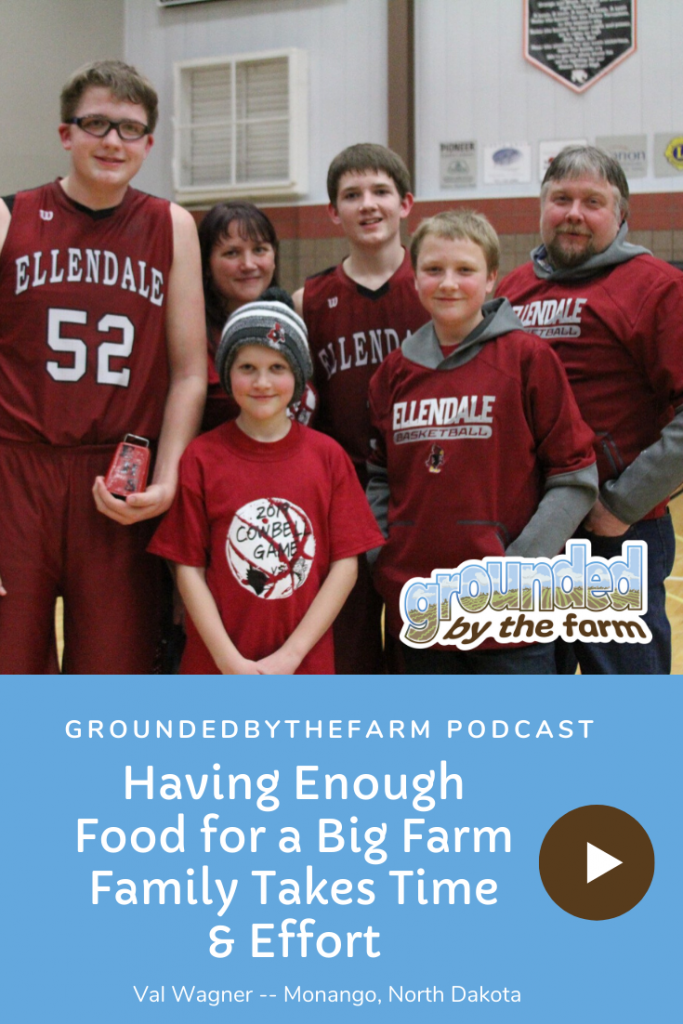 My friend Val Wagner who lives in North Dakota came to mind as she lives well away from a grocery and has a big family. I knew she’d have a lot of tips to share.
My friend Val Wagner who lives in North Dakota came to mind as she lives well away from a grocery and has a big family. I knew she’d have a lot of tips to share.
Meet Val Wagner & Her Family
The Wagners farm in the small town of Monango, North Dakota. That’s in the southeastern part of the state — an hour or so from the big towns of Jamestown, ND and Aberdeen, SD. It’s Val, who also has a job in a law office in Ellendale, ND, husband Mark who is full-time on the farm and their four boys — Ian, Scott, Evan and Eli. On the top end, Ian is graduating from high school this year and Eli is the youngest at 11.
Val explains their operation saying: “We have red Angus cattle, they are Simmental – red Angus cross. And then we also grow corn and soybean, and wheat, and then alfalfa or grass for our cows to eat, you know, most of what we grow are all things that we can consume here on the farm ourselves or eat ourselves. And then if, if we don’t need it, then our cows do. So that’s kind of we try to make sure we’re our own ecosystem if we have to be.”
Not Everyone Visits North Dakota
Val & I met via Twitter and various agriculture meetings. At some point, I did a quiz on Facebook where you say which states you’d been to, I’d made all but four to five, Val took it as a personal challenge that I had not been to North Dakota. She wanted to make it clear that I didn’t know what I was missing.
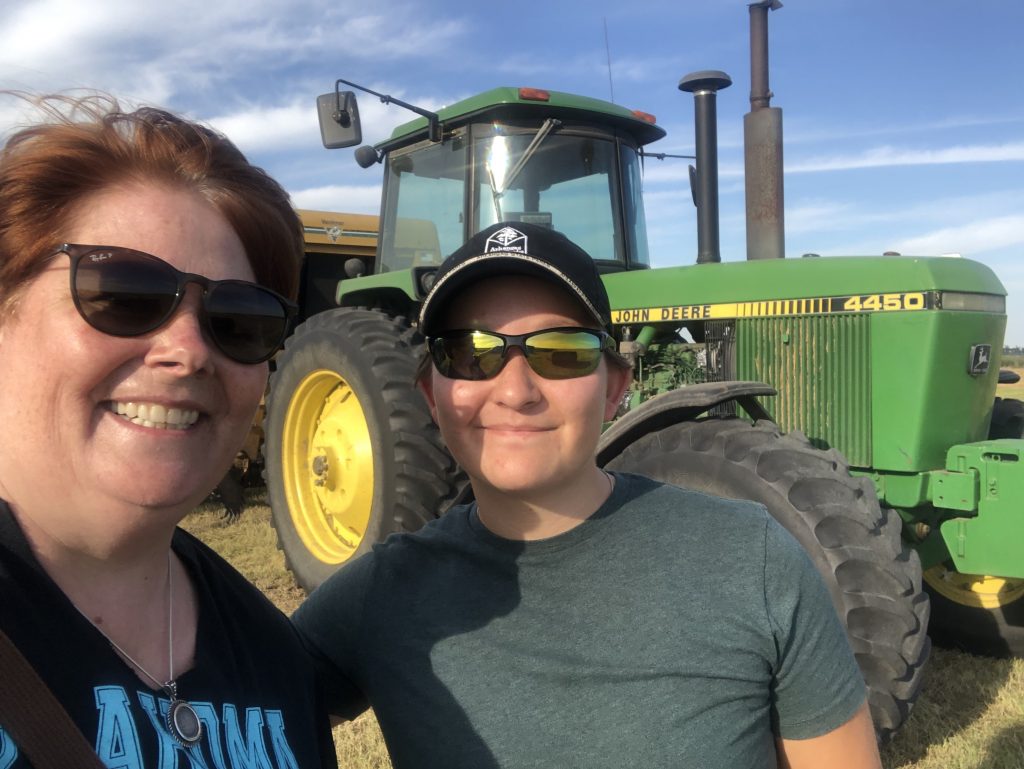
I agree with the way Val sums up her home state…. “I also knew that there was so much more here than most people even ever imagined just because we do you know, North Dakota kind of gets the bad rap of being kind of a flatland of, of nothingness. And we do have some typography. I mean, not a whole lot, but, but we also have just a lot of really cool things to experience. And, you know, the people here are the best.”
Val laughs that the difference between North Dakota and other parts of the country always is striking to her boys. “When I’ve taken my boys to other states, one of the things that have always amazed them is they just assumed trees grow in rows. Because the trees in North Dakota have all been planted. So anytime we’ve gone to somewhere like where I was born in Wisconsin, the boys are just amazed that these trees are just all over the place, and how did they ever see anything or do anything when all these trees are just all over? And it’s like, that’s how they occur naturally. We don’t have that. And so it’s sometimes it’s hard for people to understand that when we talk about wide open spaces. This is what they mean. We are wide open spaces.”
Growing Sweet Corn
The Wagners planted a few cars of sweet corn one year as part of a program with my day job. The company donated seed and farmers played it forward by donating the sweet corn in ways that benefitted their communities. Val and Mark chose to have a big picking party and donate the corn to the state’s Feeding America program.
“We actually plant generally between two to three patches of sweet corn, about one acre to a half acre in size, so about the half the size of a football field or maybe a little bigger. That’s a lot sweet corn… especially if you think about each one of those patches or that side so we’re talking two or three maybe possibly even four football fields of sweet corn. That’s a lot of sweet corn. The last two years Ian – my oldest – and Scott his, his little big brother. They’ve been using the sweet corn, they deliver it to the people in town and whoever’s looking for some and they’ll give my donation for it. And so we’ve provided sweet corn for probably a multi County area here for the last couple years. So that’s really hoping, hoping that this year we get to get the corn in again. And usually it hasn’t been a problem. But we’ve, again been dealing with moisture issues. So we’ll have to see how that that’ll go,” she explains.
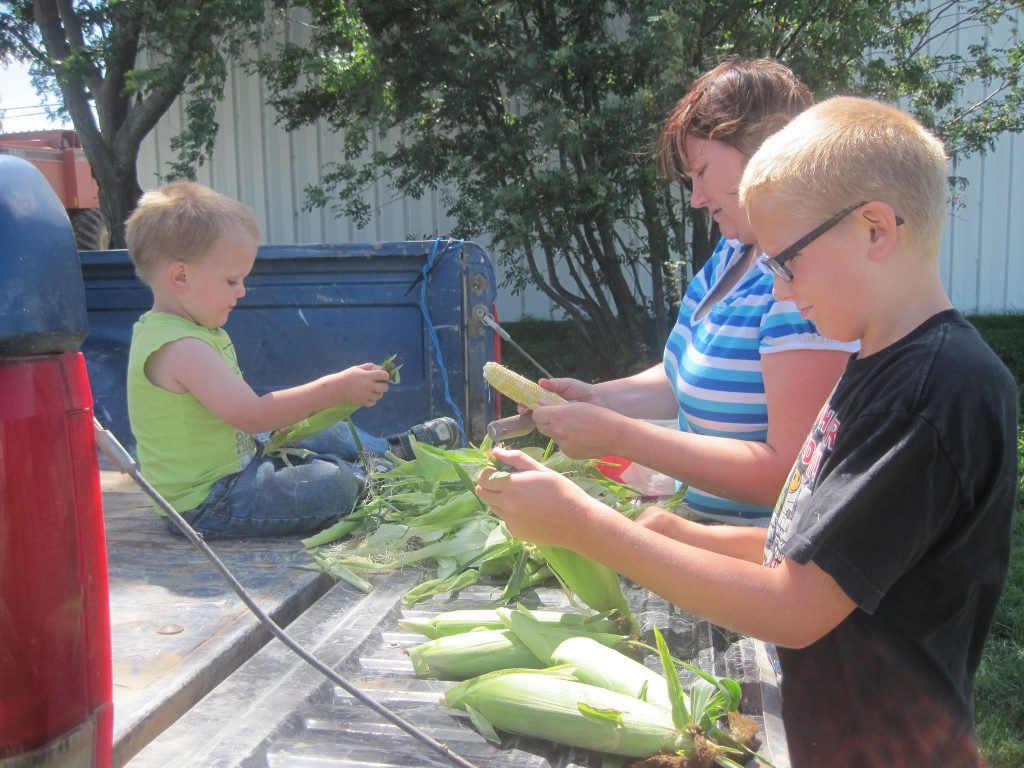
This was years ago — the son standing next to Val is the 6’8″ basketball player towering over her in the family photo above. LOL
How do you store sweet corn & other food long-term?
Picturing acres of sweet corn, even if a lot is given to friends and others, there has to be a lot left for the family. I had to ask how she tucks that away.
Val explains, “if I were to count, I believe we’ve got six or seven deep freezes that we that we have. But of course we raise not only do we raise beef but in the summer during the fair season, my boys raised for each pig so they have their animals. We’re also a hunting family. So we do hunting, when the weather allows and and timing allows. So we have a lot of space to store own food.
“We have a garden that we raised what we can when we can. I enjoy canning and I enjoy preserving food and eating our own food. Not necessarily just out of necessity because we know the closest Walmart to me is about an hour away so it’s not like it’s a drive I take every day. What’s the way our schedules are? I don’t have time to go and with having for growing boys. You know, like I said, Ian’s gonna be 18 Scott is 16 — just had a birthday. Yeah, just forget these things after a while. It was Scott, almost 6′ 8″, 2 hundred and 40 pounds. It takes a lot to fill up those long legs of his. So Evan is 13 and Eli is going to be 11. They put away a lot of food and especially now without having school. We go through enormous amount of food every day.”
She says she freezes a lot of sweet corn (my friend Leah has a great post on how to freeze sweet corn easily!) And she throws it into a lot of different things whether it be chili or a hot dish / casserole “here there whatever.”
Do you also put tomatoes up and stuff like that? What else? I ask.
“Salsa, tomato juice, bloody Mary mix, you know. Right winter gets cold. So just a whole bunch of different things whatever kind of tickles my fancy at the time the boys like pickles. I’m not I’m not very good at the cucumber thing. I don’t know. Yeah those never turn out real well,” Val admits.
Having Freezers Ready
Although I don’t have a big deep freezer, the last couple of weeks have led me to think about how I use the freezer space I do have. And I have to admit I haven’t done so well about organizing, but I’m trying to do better. I have a FoodSaver to vacuum seals things which let’s me keep it longer than store packaging and I write on them with a Sharpie.
Val laughs saying she “I probably wouldn’t need five or six freezers if I was better at the organizing. We do we stock them pretty good. We usually raise our animals, like one or two that we know we’re going to put on our own freezer. But then sometimes you might have one that injures itself, you know breaks a leg or something, especially where we’re located that when it’s icy outside like that you have those things. And so you have to be to be ready for it. Because I mean, if all the sudden you’re getting 500 pounds of meat. You can’t be like, well, I’ll just put it in the car overnight and hope it stays frozen. And you don’t have that luxury.”
We talked with Marybeth Feutz about that decision about whether the cow may be able to heal but Val helped us understand the practical side of if the cow won’t make it.
Getting Meat Processing Done
Val says they don’t do any slaughter or butchering themselves explaining “We take it all to there’s a butcher shop about 30 miles from here that we’ve worked with for many years that that does a great job for us. We take the animal in they they take care of everything for us. We just tell them what it is. We want how we want the cuts to look much as what like you would do going to your local butcher. Except we know exactly where that animal came from. And we know that what we took in is what we’re getting back. And so yeah, it just makes it a little easier for us, I think to be prepared for it. Because we do know what we’re going to have to have room for. And so that cost maybe for us, it’s not as much as buying it directly from the store, but it’s still a larger upfront cost because you’re paying for the processing of a whole animal, not just the cuts you are looking for.”
A few of our friends actually sell like quarters or halves. Friends at Spring Valley farms around Memphis does that.. they call it freezer beef. Since not many people are going to eat a quarter or a half a cow at once, the put most in the freezer.
Val says people have choices on how to have the animal cut so they get the kinds of cuts they want. “Some people don’t prefer a beef roast, but they want more steaks cut, or maybe they want it all turned into hamburger or whatever it may be. So for those people who who do more of the local, selling directly to, to the people in their communities, you have to be a little more particular about how you set that up. Because kind of like when you have a pig, everybody would like a pig to be 100% bacon, but that’s not possible.”
Focus on Herd Health
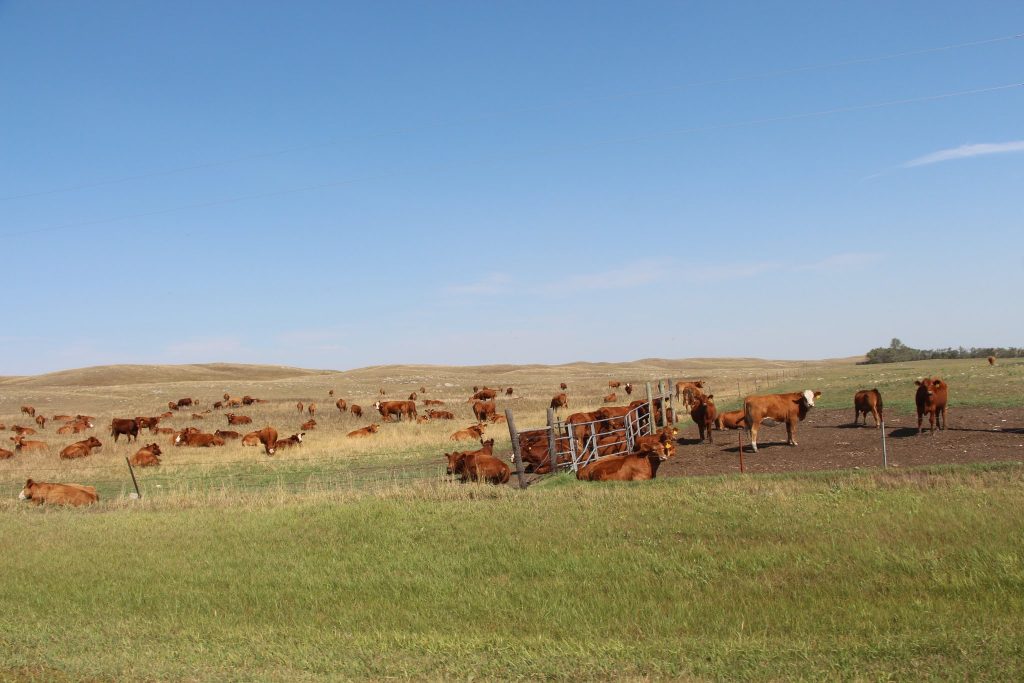
“We can be very selective as far as bloodlines and, and things like that. Because when you have a closed herd, you want to make sure you don’t have any issues with genetics and, and things being too closely related. So we keep very close records on, you know, what cow was born from, you know, the sire and for the male and the female, the mom and the dad for them and all of that, but it’s super important for us for our cows to be healthy because that we’re looking at the future of our farm. So what we do today, what we’re raising today, we’re hoping is the herd for our boys,” she says.
Val’s always talked about having her farm ready for her boys if any of them want to farm for the next generation.
“Right now it’s looking like at least two are interested in coming back to farm,” she says. “And so we want to do whatever we can to make sure that we’ve set them up in a place that there’s blessed with as many opportunities as we, as Mark and I have been. And so one of the ways we do that, when you’re looking at that herd health is making sure that we are following, you know, our veterinarian’s advice, proper techniques, making sure that we’re checking on them all the time, or we’re very involved in their care. You know, everything is very hands on for us. And so it makes it a lot of work. When you’re looking at your future everyday like that and seen it through the eyes of these boys who are excited and interested in doing that. It doesn’t make it seem like work at all.”
The cattle are moved around a range of pastures 15 miles or so from the house much of the year, but for calving, they want the cows close to the house and barn like Marybeth. She explains:
“in January, everything’s right near the farm here near our house. Usually we start calving about the second week of February. So everything is here until usually around the end of May is when we move things out to pasture. The pasture is about 17 miles from here. So we haul everything out. We used to trail them out and trail and back home, but it takes a lot of work to get them to go that far.
“We have a couple hundred acres of grass that they can eat on warm season and cool season grasses. So that means that the grasses ripen at different times so that there’s a whole bunch of variety of them. For them to eat out there and we have water tanks that they can drink from and we rotate them around so that the grass can recover and different things like that. But our hope is to not have to bring them back home until September, October, depending on what you have to deal with Mother Nature there. So it all kind of depends on what she decides to happen that year. But we leave much pasture for as long as we can bring them back home, graze them on some of the stocks that we’ve harvested if unlike this year, there wasn’t a whole lot of grazing being done because we weren’t done with harvest until late.”
2019 Was a Bad Weather Year
Farmers throughout the plains and many other areas of the US had especially tough times with the weather. Val explains the rain was historic saying:
“It was flooding that was so severe, we had a wettest spring, summer fall on record ever. We couldn’t we had people who couldn’t remember it ever being like this, where generally we may have a wet spring but then you end up with it. dry patch in the summer where everything dries out pretty well. And it gets pretty hot real quickly. And then you may end up with some moisture again in the fall but we never, there was never really a break. I think the longest we went with maybe four or five days without rain. Yeah. And it wasn’t just like a nice slow rain. It was like this. The the deluge, just tons of rain and a lot of destruction, a lot of washout. We had roads that needed repairing places he couldn’t get to because everything was just so wet. Yeah, I remember graduation last year. We had people who couldn’t get to different graduation receptions because they didn’t have four wheel drive vehicles.”
Thinking about Empty Grocery Shelves
For so many of us, having millions of acres go unfarmed feels like the type of thing that could cause food shortages but it didn’t. And here we are later looking at shelves in grocery stores that may feel like there’s a food shortage.
As someone susceptible to respiratory issues, I haven’t been shopping in almost a month. I have these lovely people from services like Instacart, who shop for me and dear friends call me on the regular to say, “Hey, we’re going out today and Do you need something?” But sometimes you can’t find flour, sugar, rice, tortillas, chicken, ground beef, etc… food is still coming off of farms, whether it’s yours or somebody else’s, and it’s getting in the system, but it may be channeled off right now for cafeterias and food service or restaurants. So to me, I wonder how much of it is it’s just in the wrong places, but a lot of people are really nervous.
Val says it just doesn’t make sense. “That’s one thing I have to say, living on the farm. I guess my biggest frustration with with the shortages that we’re seeing is that I know that you know, it is that delivery of food, that must be the issue because it’s not the availability. We’re still raising, you know, cattle from beef, there shouldn’t be a shortage. We still have crops that are waiting to be sold that are in storage. You know, we have all of these things. There’s nothing that shouldn’t be available to us because it’s, it’s all readily here. So I work in the town of Ellendale, 15 miles south of us here. Again, a very rural community that coronavirus issues just kind of ramping up here in North Dakota, we’re really kind of far behind when it comes to curve that they talked about and everything else.
“The crazy thing is that even our shelves, the toilet paper is gone, the food is gone. And I can guarantee you that we have no more people in our community than we did before. Right, you now have this ramped up all of these people who who now are fearing that there’s going to be a shortage so they’re creating a shortage.”
Planning Further Out, Eating at Home More
I think a lot of us have not been planners when it comes to our food. And we have not figured out what should you always have on hand at home so that you can tide yourself over if a big storm came. It’s just like snow every time the freakin snow storms hit right. Everybody goes out, and they buy the same things. And I think this is a little bit like that. People weren’t sure. And suddenly they have children home from school. I mean, suddenly you have four boys home from school all day every day.
Val also plans for her pantry regularly. “We plan the same way as far as making sure that our pantry has the non perishables is the important thing, because you can only plan so far ahead with your milk and things like that, because it does, it has a shelf life. But your things like your, chips and even your bread, things like that you can either put in your freezer or put in the fridge, just to make sure that you have enough to get you through. It goes a long way just to make sure that you know where we live, you’re not always guaranteed you’re going to have a trip to town. And so we make sure that you have enough to get you through a week or two that you can be comfortable and not be missing out on anything. But the big thing is, is that making sure that not only do you have some of those, the staples, but for me, the key is to make sure you have a few things that you’ve put away. That makes the day a little brighter, you know, and it doesn’t have to necessarily be just, maybe it’s some hot chocolate or maybe it’s a popcorn or something.”
Val may not realize how much I love popcorn. I have jars of Ella & Ollie popcorn nearby and bought some great flavored popcorn as I traveled. I have kept hold of one bag but will eat it this week thanks to best by dates! My mom recently made and happily ate a full pan of brownies and I keep a few things like frozen pizza around for days when I just don’t want to cook.
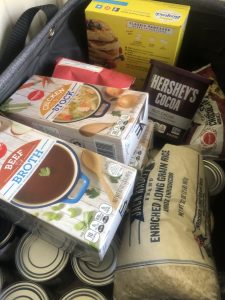
Val says her “go tos are always mac and cheese. Because my boys are connoisseurs of mac and cheese; noodles, a variety of different noodles. Because it’s amazing just changing the shape of the noodle. You may make this same dish, but if it’s a different shape of noodle, the boys will swear it tastes different. I just change which noodle I use and it’s a completely different dish, pasta sauce, different varieties of whatever it may be. I always have a ton of pasta sauce. I have a ton of beans on hand as well. So I can always throw together a batch of chili or whatever it may be. Chips. We do a lot of chips because I may make some different dips or different things like that to tide them over. You know right now, you know, at school, they’re used to eating here at seven o’clock when they get up their breakfast. Then at school, they eat at 1120 and then they eat after school and then they have supper. Well, now they eat from 8am to 8pm. And then they have a bedtime snack before they go to bed. So it’s the amount of food that they consume right now. It’s it’s just, I can’t even.”
Caring for Special Dietary Needs
The Wagners also have additional layers of interesting food issues at their house. Val explains that their youngest Eli, who will soon be 11, has a metabolic issue called OTC.
“Eli has a metabolic condition where his body doesn’t break down protein the way everybody else’s does,” she explains. “And so he has to follow a pretty strict diet of limiting protein and and as we all know, protein is a major building block of all life. And so there’s protein and literally just about everything except for junk food, like, which for him is a win win, because then he can eat all the junk food in the world that he wants to and it’s a free food for him. But it has to limit things like milk and cheese and bread and pastas, and of course, any sort of meat. Having to have things on hand for both both ends of the spectrum makes it very interesting because you know, I’ll have to say, Eli, you can only have like a half a serving of lasagna. Ian, you can eat the last chocolate chip cookie because that’s for Eli. Like, it’s just, all backwards.”
Everyone is busy. Val works a job in town at a law office and all of the sons play sports. This time of year they have been running hard and had little time at home.
“I think with that, this whole corona virus and the shelter in place and all of these things that was the hardest part was weird just on the back end of basketball season. In fact, our state basketball tournament was postponed due to to everything going on around the country. And so we had been traveling non-stop for the last five weeks and hadn’t been home probably two nights in a row that whole time. We were just getting to the point where I was going to need to do a great big shopping trip to replenish everything. When all of this happened, and it was kind of like, you go in and you realize somebody already beat me to it, there’s nothing left here. And it was crazy because trying to find all of these different things to restock my shelves and it made me really realize that I can’t let it get to that point again, even if I have to, you know, as I’m leaving town, whatever, make sure that I I am stocked up because it it is difficult when you have a larger family to make sure that you get what you need.”
May Need To Consider New Normal
I think a lot of people felt that this last week or two, especially because they didn’t know how much they would need at home with everybody at home. We never had to had to do this before. And I think now we ought to start looking, at least from my perspective, is how can we and I would say both from people like me off of the farm and people like Val on the farm, help instill a little bit more resiliency in our homes. Some farms are offering direct which I love. I ordered a box of a dozen avocados from my friend Mimi’s farm in California and I saw some more doing direct sales online and some farmers’ markets are open.
And I think more of the food system should be looking at their shifts or pivots. I hope grocery stores and others in the food system are also thinking about this, right? So granted, today a supplier is packaging things and sending it into this channel maybe food service or restaurants. I think a lot should be looking at how do we be more flexible.
I think now I at least feel like I need to slow down. Take some deep breaths. Stop any panic buying, right? It is hard when we all have so much change and you see empty shelves but we need to think less impulse and more resilient.
Supporting Local Businesses
Val says “We don’t have a lack of ability to get these items. Like there’s not we’re creating our own shortage, there isn’t a shortage. Yeah, we just have to be patient. As you know, a grocery store like mine. There’s only so much space that they have, they can’t have.”
Other grocery stores are an hour away from Val and when I lived in Mississippi it was just over an hour roundtrip. “Generally, I save those may do those shopping trips once or twice a year, I do a lot as much as I can locally just because price-wise it’s comparable when you’re talking about the amount of time you save and things like that. And I prefer to have that option nearby. And when you go through the amount of food we go through, I mean, I don’t ever intend to have milk cows and we go through a lot of milk. So I need to have it, you know, as local as possible as far as being able to pick it up. I understand the panic having somebody in my household that I have to protect, I get that as well. But especially these items that have, you know, a limited shelf life, things like that. It just, it kind of makes me scratch my head a little bit. But there are ways that that you can, you know, mitigate that and when as far as making sure that you have accessibility to to local farms.”
Val says a lot of farmers like her have freezers and are willing to share when times are hard. And I think we are seeing that with neighbors and friends here in cities too. And some offer beef locally. “When we do that, when we offer any of our beef to neighbors or friends, whatever, maybe we just drop it off at the butcher shop. They take it from there. Yeah, it’s I want to make sure that they have that direct communication with the butcher so they get what they they’re looking for, as far as cuts and all of that goes. And so there are a lot of places where you can do that. And again, there are a lot of places where, you know, what, what we get is all USDA inspected it, you know, passes all certifications and all things like that. It’s all in a licensed facility.”
What if you want to buy local meat?
I know people with cattle all around St. Louis on different sides of it right? I usually get beef through the grocery store and that’s fine with me I have occasionally gotten it directly from friends. But I imagine some people are trying to decide differently about food and their homes, this is a great time to think about that. Do you want to get some beef locally and just have more on hand? The risk is, is if the freezer goes out, you suddenly have to eat a lot of beef, or you have to get a new one really fast. I think a lot of people are going to be thinking about those and I think the more farmers who are are willing to think about well, somebody wanted to buy one from me, it’s okay.
The question is, farmers have to have them fed out . So not everybody has steers that are raised and ready for the market. If you, you talk to a farmer in your area or heck, if people really want to know, here’s how to get it, they can just leave a note on the Grounded by the Farm contact form. Help me understand where you are. And I’ll try and find a few farmers in that area. You know, I know a lot of farmers.
Val explains they don’t market that way much because they need to have business they can count on, but they are glad to work with people. “We don’t do the majority of our marketing that way. Because, one, it’s a very, you know, hot and cold up and down. And someplace where we know, when they’re ready to go to market, they’re ready to go to market. And so I need, we need to make sure we have that stability. And then the other thing is that, when somebody does want to have a beef or a quarter of beef, that doesn’t mean that there’s one ready today, you know, so maybe that’s great. We’ll have one ready for you in June, so that you can have those conversations so that you can plan around it.
“It takes time to make sure that that meat is ready so that it’s the taste and texture and everything is, is, you know, we’re all about food experiences. And as a farmer, I just want to make sure that whatever you get from our farm truly leaves a good taste in your mouth for a farm like that. You know, I want to make sure that you get done eating that night and you have a smile on your face and your stomach is full and and you are grateful to have that experience. So you know, it takes time to get it to that point. So we want to make sure that everything is is done right and that you don’t cut any corners just to make sure that you hit a certain timeframe.”
Find Val Wagner Online
You can find me online Wag’n Tales (wagfarms.com) is is the blog that I use Right, and I’m getting back into it again. You can find me at @wagfarms on Twitter, Val Wagner or Wag’n Tales on Facebook. I enjoy talking to anybody about agriculture and what we do here. And what’s the future of agriculture may look like? I’m looking forward to seeing the world that my boys leave for the next generation as well.

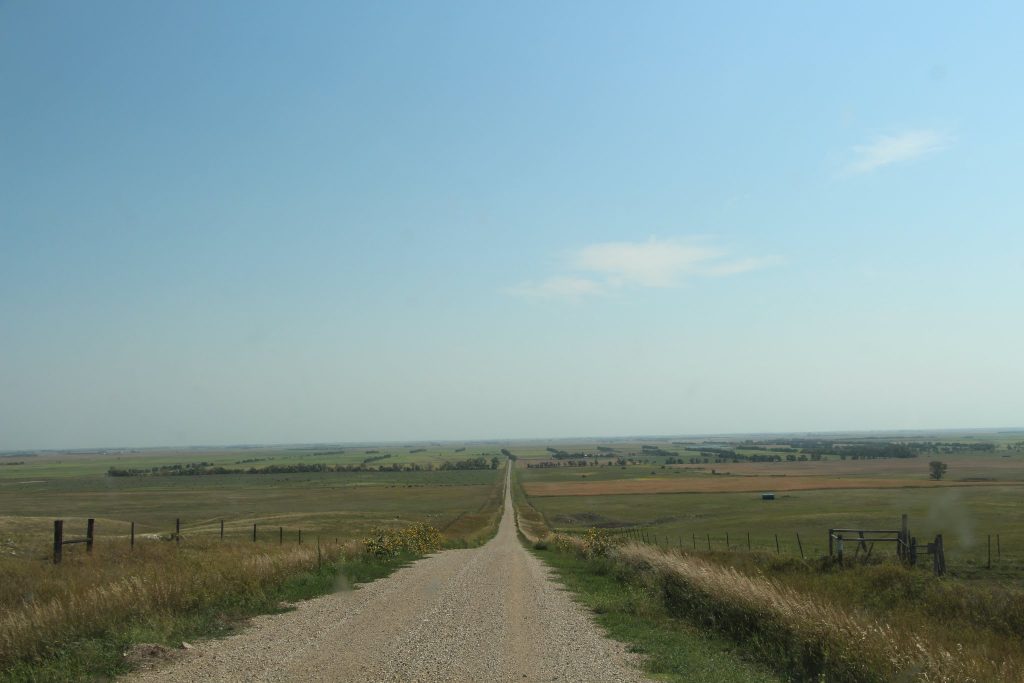


3 comments on “Having Enough Food for a Farm Family Takes Time & Effort”